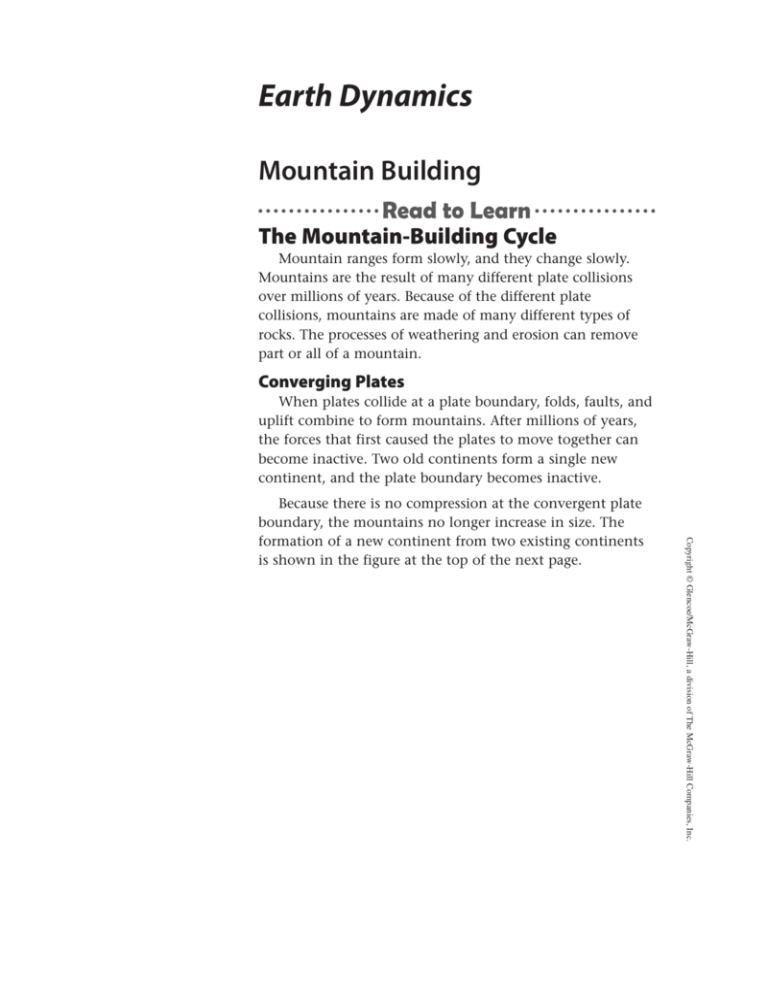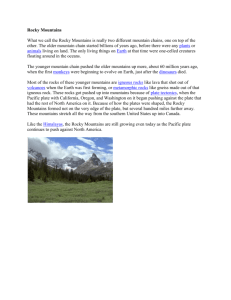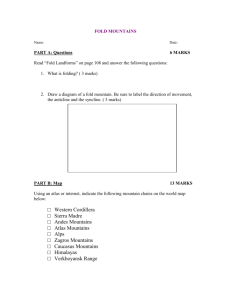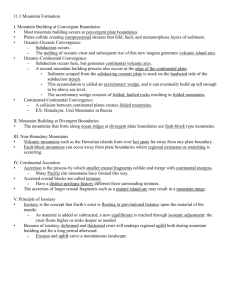Earth Dynamics
advertisement

Earth Dynamics Mountain Building The Mountain-Building Cycle Mountain ranges form slowly, and they change slowly. Mountains are the result of many different plate collisions over millions of years. Because of the different plate collisions, mountains are made of many different types of rocks. The processes of weathering and erosion can remove part or all of a mountain. Converging Plates When plates collide at a plate boundary, folds, faults, and uplift combine to form mountains. After millions of years, the forces that first caused the plates to move together can become inactive. Two old continents form a single new continent, and the plate boundary becomes inactive. Copyright © Glencoe/McGraw-Hill, a division of The McGraw-Hill Companies, Inc. Because there is no compression at the convergent plate boundary, the mountains no longer increase in size. The formation of a new continent from two existing continents is shown in the figure at the top of the next page. Formation of a New Continent New continent Continent 1 Subduction zone Continent 2 Mantle Mantle Collisions and Rifting Continents are always changing because Earth’s tectonic plates are always moving. When continents split at a divergent plate boundary, they often break close to the place where they first collided. First a large split, or rift, forms. The rift grows, and seawater flows into it. In time, an ocean forms. Copyright © Glencoe/McGraw-Hill, a division of The McGraw-Hill Companies, Inc. Eventually plate motion changes again, and the continents will collide. New mountain ranges form on top of or next to older mountain ranges. The cycle of repeated collisions and rifting can create old and complicated mountain ranges, such as the Appalachian Mountains. Rocks that make up mountain ranges record the history of plate motion and collisions that formed the mountains. Weathering The Appalachian Mountains are an old mountain range that stretches along most of the eastern United States. They are not as high or as rugged as the Rocky Mountains in the west because they are much older. They are no longer growing. Weathering has rounded the peaks and lowered the elevations. Erosion and Uplift Over time, natural processes wear away mountains, smooth their peaks, and reduce their height. Even so, some mountain ranges are hundreds of millions of years old. Why don’t the ranges completely disappear? Recall how isostasy works. As a mountain erodes, the crust under it must rise to restore the balance between what is left of the mountain above the surface and the root that floats within the mantle. Therefore, rocks deep under continents rise slowly toward Earth’s surface. In old mountain ranges, metamorphic rocks that formed deep below the surface became exposed on the top of mountains. When the material above the rocks eroded, the rocks rose due to isostasy. Types of Mountains You learned in the first lesson that stresses caused by plate movement can pull or compress crust. This is one way that plate motion forms many types of mountains. But the effects of plate movement help change the positions of rocks. Plate movement can also change the rocks within a mountain range. Folded Mountains Rocks that are deeper in the crust are warmer than rocks closer to Earth’s surface. Deeper rocks are also under much more pressure. When rocks are hot enough or under enough pressure, folds form instead of faults. Folded mountains are made of layers of rocks that are folded. Folded mountains form as continental plates collide, folding and uplifting layers of rock. When erosion removes the upper part of the crust, folds are exposed on the surface. Fault-Block Mountains Sometimes tension stresses within a continent form mountains. As tension pulls crust apart, faults form. At the faults, some blocks of crust fall and others rise. Fault-block mountains are parallel ridges that form where blocks of crust move up or down along faults. A fault-block mountain might appear as a high, craggy ridge next to a valley. Somewhere between the two is a fault where huge movement once occurred. The parallel ridges of fault-block mountains run perpendicular to the direction of the stress. If the ridges run north to south, then the tension that created them pulled east and west. Uplifted Mountains The granite on top of the Sierra Nevada’s Mount Whitney was once 10 km below Earth’s surface. Now it is on top of a 4,400-m-tall mountain! How did this happen? Mount Whitney is an uplifted mountain. When large regions rise vertically with very little deformation, uplifted mountains form. Copyright © Glencoe/McGraw-Hill, a division of The McGraw-Hill Companies, Inc. The arrangement of the folds is not accidental. You can show this with a piece of paper. Gently push the ends of a sheet of paper toward one another to form a fold. The fold is a long ridge that is perpendicular to the direction in which you pushed. Folded mountains are similar. The folds are perpendicular to the direction of the compression that created them. Like your paper, when folds run up and down in a mountain, the compression must have come from the sides. Formation of Uplifted Mountains Compression causes uplift. Uplifted mountain Crust Upper mantle Part of cold mantle starts to detach. Lower mantle Copyright © Glencoe/McGraw-Hill, a division of The McGraw-Hill Companies, Inc. The rocks in the Sierra Nevada are made of granite. Granite is an igneous rock that forms several kilometers below Earth’s surface. Uplift and erosion have exposed it. Scientists do not fully understand how uplifted mountains form. One hypothesis is shown in the figure above. It proposes that cold mantle under the crust breaks loose or detaches from the crust. It then sinks deeper into the mantle. The sinking mantle pulls the crust and causes compression closer to the surface. As the crust thickens due to the compression, the upper part of the crust rises as it maintains isostasy. Sometimes it rises high enough to form huge mountain ranges. Geologists are designing experiments to test this hypothesis. Volcanic Mountains You might not think of volcanoes as mountains, but scientists consider volcanoes to be special types of mountains. In fact, volcanic eruptions formed some of the largest mountains on Earth. As molten rock and ash erupt onto Earth’s surface, they harden. Over time, many eruptions can build huge volcanic mountains such as the ones that make up the Hawaiian Islands. Not all volcanic mountains erupt all the time. Some volcanic mountains are dormant. This means that they might erupt again someday. Some volcanic mountains will never erupt again.







